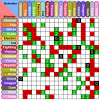Chinese Checkers
About Chinese Checkers
Chinese Checkers is a classic board game that can be played by two to six players. It involves moving your pieces across the board with the objective of being the first to move all your pieces into the opposite triangle. Here's a guide on how to play Chinese Checkers along with its mechanics and rules:
Setup:
- The game board is in the shape of a six-pointed star, consisting of a series of interconnected triangles.
- Each player chooses a colored set of ten pegs or marbles and places them in the corresponding starting triangle.
- The starting triangle is the one closest to each player, and the color of the triangle matches the color of their pieces.
Gameplay:
- Players take turns moving their pieces in a clockwise direction.
- A move consists of either moving a single piece into an adjacent empty space or jumping over one or more pieces, including your own or your opponents', in a straight line.
- The jumps can be made over any number of pieces as long as there are empty spaces immediately beyond them.
- Pieces can only move in straight lines, not diagonally, and they cannot move or jump backward.
Objective:
- The goal is to be the first player to move all of their pieces into the triangle opposite their starting triangle.
- Players strive to make strategic moves that allow them to advance their pieces while blocking or impeding their opponents' progress.
Hop and Capture:
- When a piece jumps over another piece (either their own or an opponent's), the jumped piece is not removed from the board.
- However, capturing multiple pieces in a single move is allowed and encouraged, as it opens up more opportunities for advancing across the board quickly.
- Captured pieces can become obstacles for other players, hindering their progress.
Single and Multiple Jumps:
- Players can make single jumps, where they move a piece into an adjacent empty space, or they can make multiple jumps in a row.
- In multiple jumps, a player moves a piece, jumps over one or more pieces, lands in an empty space, and then continues jumping in the same turn until they can no longer make valid jumps.
Winning:
- The first player to successfully move all their pieces into the opposite triangle (also known as the "home" or "base") wins the game.
- It's possible for the game to end in a tie if multiple players achieve this goal in the same turn.
Variations and Additional Rules:
- Chinese Checkers can have variations in terms of the number of players, board size, and starting positions.
- Some versions allow for "hopping" moves, where pieces can move to any empty space adjacent to them, rather than strictly jumping over other pieces.
Remember, the specific rules and variations may differ slightly depending on the version or house rules being followed. It's advisable to review the specific rule set you're using before playing a game of Chinese Checkers.
How to play
using mouse




































































